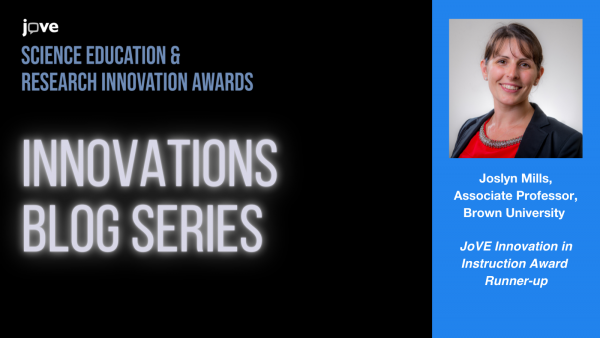The 2021 JoVE Science Education and Research Innovation Awards aimed to recognize and celebrate creative solutions to assist faculty members worldwide in joining the future-focused learning network. This series of blog posts consolidates themes, notes, and resources collated from outstanding entries received from faculty members worldwide. It includes meaningful insights and innovative ideas from a global community of educators, aiming to accelerate the transformation and deepen the impact of science courses. Below you can read the entry by Joslyn Mills, Associate Professor at Brown University.
For the past three years, I have taught a Course-based Research Experience (CRE) course that allows a classroom of students to perform discovery-based research using reverse genetics in C. elegans. In a typical semester, the students would come into the lab and perform an RNAi screen, select a gene hit to write a proposal about, execute their proposed experiments, and report their findings in written and oral communications. However, the pandemic shook the world of undergraduate and high school laboratory training to the core. How could we teach these students if they couldn’t be at the bench doing the experiments? I learned that there is more to scientific research training than benchwork but that it is not simply a matter of putting material online, so I had to rework my course from the ground up. Thankfully, there is a plethora of educational media publicly available and the technology to create some myself, and my university supported the transition of my course to an online platform.
The shift from training undergraduates and high school students in the lab to virtual was a challenge, from humanizing the course and building a community to keeping students engaged and interested. I used a “Meet the Professor” video using an unaltered background of my office, complete with interruptions from my cats. This video not only put a face to the text the students received, but my candidness portrayed me as an authentic person, demonstrating to them that everyone is in this together. To encourage student-student communication, they were required to interact via weekly discussion boards and eventually form groups that they worked with to write their proposals. Each group proposed at least two experiments that my assistant and I performed in the lab, and the results were shared with the students so they could do the analysis and form conclusions. So instead of focusing on the hands-on technical skills they couldn’t do at home, I emphasized the scientific method and research practices beyond the bench; however, I supplemented lectures and assignments with videos of lab techniques to show the students how the experiments would look if they were to perform them and live “lab look-ins” to give them a sense of being in the lab. The technique videos were either filmed by myself or sourced from various publishers, many coming from JoVE, Brown University’s SciToons, and Khan Academy. Importantly, since we didn’t have the students in a physical lab space where we could observe them performing their tasks, we offered video demonstrations of how to complete assignments in addition to the written instructions (Figure 4 in supporting material.) Ultimately, the students were still able to perform relevant discovery-based research that contributed to the research community, work collaboratively with their group and their instructors, and revisit techniques and approaches over the course to grasp the concepts successfully- everything a CURE course aims to be all from the comfort of their homes.
As much of a difficulty as it was, so many benefits come from revamping my course. First, students from all over the world could participate that might have otherwise been restricted due to the cost of travel and boarding. Second, we now have all the lecture and assessment material easily accessible for others that would like to teach the course at a different institution. Finally, even as we transition back to in-person instruction, I have decided to continue to use my educational media in a flipped-classroom approach; this way, students can strictly focus on performing their experiments during scheduled class time rather than have me taking that valuable time to give a lecture they can watch outside of class. This increases the overall efficiency and effectiveness of the training, which benefits the students, instructors, and the research community. I have used several JoVE videos in my classes, with the most used ones being the C. elegans maintenance, behavior assays, and biochemistry. Based on the direction of students’ projects, I shared some paralysis assay articles or starvation assay articles and also referred students to the JoVE Science Education Database for C. elegans for further clarification in my in-person classes. While this has been more of an informal teaching method, I plan to incorporate it more into the curriculum.
Please see below a list of JoVE videos used:
- The Nematode Caenorhabditis Elegans – A Versatile In Vivo Model to Study Host-microbe Interactions
- Biology I: yeast, Drosophila and C. elegans.
- C. elegans Chemotaxis Assay
- Combined Nucleotide and Protein Extractions in Caenorhabditis elegans
- Assaying β-amyloid Toxicity using a Transgenic C. elegans Model
- Solid Plate-based Dietary Restriction in Caenorhabditis elegans
Get in touch here to learn more about how JoVE videos can help you increase student engagement in your classes.


